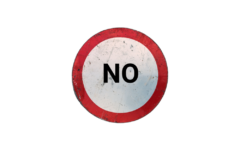The Voice Referendum: ‘No’ Supporters Vandalise Sydney Street Signs

The Voice has caused its fair share of controversy over the past few weeks, and by now most of us are not new to the idea that one side has to be ‘right’ and the other side therefore is ‘wrong’.
It seems that here in Australia, we’re losing our ability to debate politely, logically, reasonably and intelligently, and in many cases, remain respectful of opposing views.
Suffice it to say, the current divide between YES and NO supporters is palpable.
And it has led to some unfortunate criminal behaviour with complaints about misinformation campaigns, trolling and online bullying, as well as vandalism on streets, footpaths and in public spaces. The most serious act of vandalism to date has been the altering of speed signs on the M1 and Pacific Highway in New South Wales.
Speed signs say ‘NO’
Several road signs between Hornsby and Newcastle were tampered with in recent days. Vandals had used black tape to turn the 110 km/h signs into the word “NO”.
Similar acts of vandalism have also occurred in South Australia and Victoria during The Voice campaign.
Damaging public property can land a person on the wrong side of the law, although it may be understandable given that protesting has been largely criminalised by the NSW Government.
Transport For NSW moved quickly to fix the signs and police have been notified.
Most of our highways and main roads have detection cameras, and no doubt some passing motorists may have dash cam footage, so if the vandals are actually caught, they will face a severe penalty because defacing road safety or road speed signage is potentially very dangerous.
In New South Wales, vandalism can be prosecuted under laws which make intentional or reckless damage to property, and applying graffiti without the owner’s consent, a criminal offence.
Intentional or reckless damage to property
Section 195 of the Crimes Act 1900 (NSW) prescribes a maximum penalty of 5 years in prison for any person who intentionally or recklessly destroys or damages property belonging to another.
Intentionally means wilfully or purposely, while recklessly means foreseeing the possibility of damage or destruction but proceeding regardless.
The courts have found that property is considered to have been damaged where:
- There is permanent damage,
- There is temporary functional derangement,
- There is temporary impairment of usefulness,
- The physical integrity of the property is altered, and
- The property is rendered imperfect or inoperative.
Examples of conduct found by the courts to constitute damage include:
- Placing a blanket in a toilet and flushing,
- Letting down the tyres of a car,
- Painting graffiti on walls or floors,
- Breaking a raw egg on the windscreen of a car, and
- Taking a cap from a person’s head and repeatedly stomping on it.
It has been held that temporarily blocking another from accessing property is not enough to establish the offence.
The maximum penalty increases to ten years in prison where the offence occurs ‘in company’, which means with another person or persons.
The offence of applying graffiti in New South Wales
Section 4 of the Graffiti Control Act 2008 (NSW) prescribes a maximum penalty of four penalty units, or $440, for intentionally marking any premises or property without the consent of the occupier or, where the premises is unoccupied, the person in charge.
The section makes clear that the offence does not apply to the marking of any public footpath or public pavement with chalk, including, but not limited to, marking out a hopscotch or handball court with chalk.
The maximum increases to 12 months in prison and/or a fine of 20 penalty units, or $2,200, where the offence is committed in ‘circumstances of aggravation’ – which means by the use of any ‘graffiti implement’ or in such a manner that the mark is not readily removable by wiping or using water or detergent.
A ‘graffiti implement’ is defined as spray paint, a marker pen, or any implement designed or modified to produce a mark that is not readily removable by wiping or by use of water or detergent.
‘Spray paint’ includes any liquid or other substance that is designed to stain, mark or corrode and to be applied from a spray can, and includes the spray can.
Under the Act, is it also an offence to sell or supply spray paint cans to anyone under the age of 18 years, and it is also an offence to carry ‘a graffiti implement’.
For shopkeepers, the law states: a person who sells a spray paint can to a person under the age of 18 years is guilty of an offence. The maximum penalty is a fine of $110. It may be a defence if the seller reasonably believed that the person buying the spray can was over the age of 18 years.
If an employee contravenes this law, then the employer is taken to have contravened that subsection, whether or not the employee contravened the provision without the employer’s authority or contrary to the employer’s orders or instructions.
It is a defence to a prosecution against an employer for such a contravention if it is proved:
(a) that the employer had no knowledge of the contravention, and
(b) that the employer could not, by the exercise of due diligence, have prevented the contravention.
Retailers are also required, by law, to keep spray cans locked away.
Fines are the most common penalty for graffiti offences
The most common penalty for a graffiti offence under the Graffiti Control Act is a fine, and this is in acknowledgement of the fact that most graffiti offences are conducted by youths.
Courts can also impose a “clean up order” which means that a person can work to remove the graffiti without having to pay a fine. Courts can also order offenders to participate in a graffiti prevention program.







